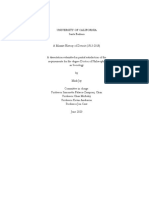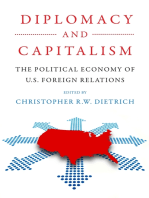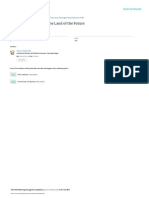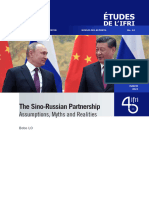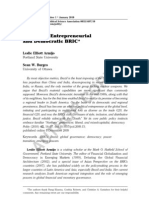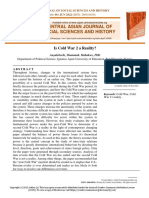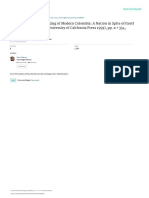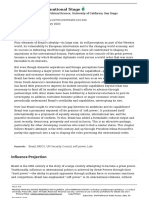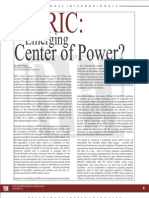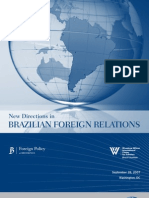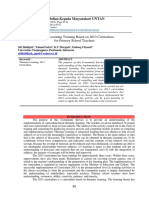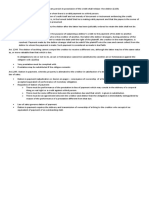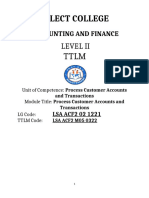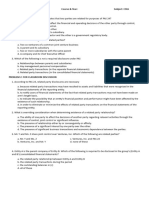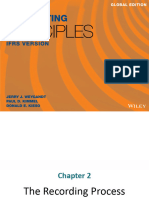BRICS Analysis1
BRICS Analysis1
Uploaded by
Dwight AckermanCopyright:
Available Formats
BRICS Analysis1
BRICS Analysis1
Uploaded by
Dwight AckermanOriginal Title
Copyright
Available Formats
Share this document
Did you find this document useful?
Is this content inappropriate?
Copyright:
Available Formats
BRICS Analysis1
BRICS Analysis1
Uploaded by
Dwight AckermanCopyright:
Available Formats
See discussions, stats, and author profiles for this publication at: https://www.researchgate.
net/publication/299585324
Similarities and Differences Between the Two Most Important Economic and
Geopolitical Analysis about the BRICS written by Pepe Escobar and Professor
Michel Chossudovsky from Global...
Research · April 2016
DOI: 10.13140/RG.2.1.4747.6883
CITATIONS READS
0 2,637
1 author:
Enrique Raul Suarez
Harvard University
27 PUBLICATIONS 1 CITATION
SEE PROFILE
Some of the authors of this publication are also working on these related projects:
Peace Dignity and Prosperity: Putting People before Profits View project
The Current State of the World: The Unexamined Life is not Worth Living (Socrates) View project
All content following this page was uploaded by Enrique Raul Suarez on 03 April 2016.
The user has requested enhancement of the downloaded file.
Similarities and Differences Between the Two Most
Important Economic and Geopolitical Analysis about the
BRICS written by Pepe Escobar and Professor Michel
Chossudovsky from Global Research, Canada
By:
Enrique Suarez
Master of Education & International Development
Harvard University, Cambridge, USA
http://www.wix.com/suarezenrique/delta
USA
In an article called " BRICS Trample U.S. in South America", Global Research, May 23, 2015,
Mr. Escobar argues that the trampling started in April with a rash of deals between Argentina
and Russia during President Cristina Kirchner’s visit to Moscow.
And it continues with a $53 billion investment bang as Chinese Premier Li Keqiang visits Brazil
during the first stop of yet another South American commercial offensive – complete with a
sweet metaphor: Li riding on a made in China subway train that will play a new metro line in Rio
de Janeiro ahead of the 2016 Olympics.
Enrique Suarez Page 1
Where is the US in all this? Nowhere according to Mr. Escobar; little by little, yet inexorably,
BRICS members China – and in a smaller measure, Russia – have been no less than
restructuring commerce and infrastructure all across Latin America.
Countless Chinese commercial missions have been plying these shores non-stop, much as the
US did between World War I and II. In a key meeting in January with Latin American business
leaders, President Xi Jinping promised to channel $250 billion for infrastructure projects in the
next 10 years.
According to Escobar, top infrastructure projects in Latin America are all being financed by
Chinese capital – except the Mariel port in Cuba, whose financing comes from Brazil’s BNDES
and whose operation will be managed by Singaporean port operator PSA International Pte Ltd.
Construction of the Nicaragua canal – bigger, wider and deeper than Panama’s – started last
year by a Hong Kong firm, to be finished by 2019. Argentina, for its part, clinched a $4.7 billion
Chinese deal for the construction of two hydroelectric dams in Patagonia.
Among the 35 deals clinched during Li’s visit to Brazil, I found out there was financing worth $7
billion for Brazil’s oil giant Petrobras; 22 Brazilian Embraer commercial jets to be sold to Tianjin
Airlines for $1.3 billion; and a raft of agreements involving top iron ore producer Vale. Chinese
investment might go some way into overhauling Brazil’s appalling network of roads, railways
and ports; airports are in slightly better condition due to upgrades prior to the World Cup last
year.
According to Escobar, the star of the whole show is undoubtedly the proposed $30 billion, 3,500
kilometer-long, Atlantic-Pacific mega-railway, that is slated to run from the Brazilian port of
Santos to the Peruvian Pacific port of Ilo via Amazonia. Logistically, this is a must for Brazil,
offering it a Pacific gateway. Winners will inevitably be commodity producers – from iron ore to
soya beans – exporting to Asia, mostly China.
The Atlantic-Pacific railway may be an extremely complex project – involving everything from
environmental and land rights issues to, crucially, the preference for Chinese firms every time
Chinese banks deliberate on extending lines of credit. But this time, it’s a go. The usual
suspects (The US) are – what else - worried according to Escobar..
The Geopolitics Game
According to Escobar, official Brazilian policy, since the Lula years, has been to attract top
Chinese investment. China is Brazil’s top trading partner since 2009; it used to be the US. The
trend started with food production, now it moves to investment in ports and railways, and the
next stage will be technology transfer. The BRICS New Development Bank and the China-led
Asian Infrastructure Investment Bank (AIIB), of which Brazil is a key founding member, will
definitely be part of the picture.
Likewise, I also share Mr. Escobar's assessment that the problem is this massive
trade/commerce BRICS interplay which is intersecting with a quite convoluted political process.
Enrique Suarez Page 2
The top three South American powers – Brazil, Argentina and Venezuela, which also happen to
be Mercosur members – have been facing repeated “destabilization” attempts by the usual
suspects, who routinely denounce the foreign policy of Presidents Dilma Rousseff, Cristina
Kirchner and Nicolas Maduro and yearn for the good old’ days of a dependent relationship with
Washington.
With different degrees of complexity – and internal strife – Escobar argues that Brasilia, Buenos
Aires and Caracas are all simultaneously facing plots against their institutional order which in
my opinion is self-evident. The usual suspects don’t even try to dissimulate their near total
diplomatic distance from the South American Top Three.
Venezuela, under US sanctions, is considered a threat to US national security – something that
does not even qualify as a bad joke. Kirchner has been under relentless diplomatic assault – not
to mention US vulture funds targeting Argentina. And with Brasilia, relations are practically
frozen since September 2013, when Rousseff suspended a visit to Washington in response to
the NSA spying on Petrobras, and herself personally.
And that leads us to a crucial geostrategic issue – so far unresolved according to Mr. Escobar.
NSA spying may have leaked sensitive information on purpose to destabilize the Brazilian
development agenda – which includes, in the case of Petrobras, the exploration of the largest oil
deposits (the pre-salt) found so far in the young 21st century.
According to Escobar, what is unraveling is so crucial because Brazil is the second-biggest
economy in the Americas (after the US); it is the biggest Latin American commercial and
financial power; it hosts the former second-biggest development bank in the world, BNDES, now
overtaken by the BRICS bank; and it also hosts the biggest corporation in Latin America,
Petrobras, also one of the world’s top energy giants.
Therefore, the hardcore pressure against Petrobras, I believe, comes essentially from US
shareholders – who act like the proverbial vultures, bent on bleeding the company and profit
from it, allied with lobbyists who abhor Petrobras’s status as the priority explorer of the pre-salt
deposits.
In a nutshell, Brazil is the last great sovereign frontier against unbounded hegemonic
domination in the Americas.
BRICS Evolving Strategic Partnership
I agree with Mr. Escobar that the constantly evolving strategic partnership of the BRICS nations
has been met by Washington circles not only with incredulity but fear. Most importantly, it’s
virtually impossible for Washington to do real damage to China – but much “easier”,
comparatively, in the case of Brazil or Russia. Even though Washington’s wrath targets
essentially China – which has dared to do deal after deal in the former “America’s backyard” as
Mr. Escobar correctly pointed out.
Enrique Suarez Page 3
Once again, the Chinese strategy, according to Escobar, as much as the Russian, is to keep
calm and carry a “win-win” profile. Xi Jinping met with Maduro in January to do – what else –
deals. He met with Cristina Kirchner in February to do the same – just as speculators were
about to unleash another attack against the Argentine peso. Now there’s Li’s visit to South
America.
Needless to say, trade between South America and China continues to boom. Argentina exports
food and soya beans; Brazil the same, plus oil, minerals and timber; Colombia sells oil and
minerals; Peru and Chile, copper, and iron; Venezuela sells oil; Bolivia, minerals. China exports
mostly high-value-added manufactured products.
A key development to watch according to Mr. Escobar in the immediate future is the Transul
Project, which was first proposed at a BRICS conference last year in Rio. It boils down to a
Brazil-China strategic alliance linking Brazilian industrial development to partial outsourcing of
metals to China; as the Chinese increase their demand – they are building no less than 30
megalopolises up to 2030 – that will be met by Brazilian or Sino-Brazilian companies. Beijing
has finally given its seal of approval.
So the long-term Big Picture remains inexorable according to Escobar; BRICS and South
American nations – which converge in the Unasur (The Union of South American Nations) – are
betting on a multipolar world order, and a continental process of independence.
And like Mr. Escobar says, it’s easy to see how that is oceans away from a Monroe doctrine.
On the other hand, in an article called "BRICS and the Fiction of “De-Dollarization” written by
professor Michel Chossudovsky on April 8, 2015, he argues that,
The financial media as well as segments of the alternative media are pointing to a possible
weakening of the US dollar as a global trading currency resulting from the BRICS (Brazil,
Russia, India, China, South Africa) initiative.
One of the central arguments in this debate on competing World currencies according to
Chossudovsky, hinges on the BRICS initiative to create a development bank which, according
to analysts, challenges the hegemony of Wall Street and the Washington based Bretton Woods
institutions.
The BRICS New Development Bank (NDB) was set up to challenge two major Western-led
giants – the World Bank and the International Monetary Fund. NDB’s key role will be to
serve as a pool of currency for infrastructure projects within a group of five countries with major
emerging national economies – Russia, Brazil, India, China and South Africa. (RT, October 9,
2015, emphasis added)
More recently, according to Michel Chossudovsky, emphasis has been placed on the role of
China’s new Asia Infrastructure Investment Bank (AIIB), which, according to media reports,
Enrique Suarez Page 4
threatens to “transfer global financial control from Wall Street and City of London to the new
development banks and funds of Beijing and Shanghai”. The decision to create general
reserves was made in July 2014 at the Sixth Summit of BRICS at Fortaleeza in Brazil. Source:
AP.
Likewise, Chossudovsky argues, that while the creation of BRICS has significant geopolitical
implications, both the AIIB as well as the proposed BRICS Development Bank (NDB) and its
Contingency Reserve Arrangement (CRA) are dollar denominated entities. Therefore, he argues
that unless they are coupled with a multi-currency system of trade and credit, they do not
threaten dollar hegemony. Quite the opposite, they tend to sustain and extend dollar
denominated lending and they replicate several features the Bretton Woods framework, argues
Chossudovsky,
Towards a Multi-Currency Arrangement?
Chossudovsky argues from a geopolitical standpoint that China and Russia are developing a
ruble-yuan swap, negotiated between the Russian Central Bank, and the People’s Bank of
China while the situation of the other three BRICS member states (Brazil, India, South Africa)
with regard to the implementation of (real, rand rupiah) currency swaps is markedly different.
According to Chossudovsky, these three highly indebted countries are in the straightjacket of
IMF-World Bank conditionalities which means that they do not decide on fundamental issues of
monetary policy and macro-economic reform without the green light from the Washington based
international financial institutions.
In addition, Chossudovsky argues that currency swaps between the BRICS central banks was
put forth by Russia to:
“Facilitate trade financing while completely bypassing the dollar. “At the same time, the new
system will also act as a de facto replacement of the IMF, because it will allow the members of
the alliance to direct resources to finance the weaker countries.” (Voice of Russia)
While I have learned that Russia has formally raised the issue of a multi-currency arrangement,
the Development Bank’s structure does not currently “officially” acknowledge such a framework
as Chossudovsky has asserted. The Russians have also noted:
“We are discussing with China and our BRICS partners the establishment of a system of
multilateral swaps that will allow to transfer resources to one or another country, if needed. A
part of the currency reserves can be directed to [the new system]” (Governor of the Russian
Central Bank, June 2014, Prime news agency)
It is also worth saying that India, South Africa and Brazil have decided not to go along with a
multiple currency arrangement, which would have allowed for the development of bilateral
trade and investment activities between BRICs countries, operating outside the realm of
dollar denominated credit. In fact they did not have the choice of making this decision in view
of the strict loan conditionalities imposed by the IMF.
Enrique Suarez Page 5
Heavily indebted under the brunt of their external creditors, all three countries are faithful pupils
of the IMF-World Bank according to Chossudovsky. He argues that the central bank of these
countries is controlled by Wall Street and the IMF. For them to enter into a “non-dollar” or an
“anti-dollar” development banking arrangement with multiple currencies, would have required
prior approval of the IMF.
The Contingency Reserve Arrangement
The CRA is defined as a “framework for provision of support through liquidity and precautionary
instruments in response to actual or potential short-term balance of payments pressures.”
(Russia India Report April 7, 2015). In this context, the CRA fund does not constitute a “safety
net” for BRICS countries according to Chossudovsky because it accepts the hegemony of the
US dollar which is sustained by large scale speculative operations in the currency and
commodity markets.
In essence the CRA operates in a similar fashion to an IMF precautionary loan arrangement
(e.g. Brazil November 1998) with a view to enabling highly indebted countries to maintain the
parity of their exchange rate to the US dollar, by replenishing central bank reserves through
borrowed money.
Therefore, according to Chossudovsky, the CRA excludes the policy option of foreign exchange
controls by BRICS member states. In the case of India, Brazil and South Africa, this option is
largely foreclosed as a result of their agreements with the IMF.
Worse, according to Chossudovsky, the dollar denominated $100 billion CRA fund is a “silver
platter” for Western “institutional speculators” including JP Morgan Chase, Deutsche Bank,
HSBC, Goldman Sachs et al, which are involved in short selling operations on the Forex market.
Ultimately the CRA fund will finance the speculative onslaught in the currency market.
National Currencies vs. Neoliberalism
Furthermore, Chossudovsky argues that an arrangement using national currencies instead of
the US dollar requires sovereignty in central bank monetary policy. In many regards, India,
Brazil and South Africa are (from the monetary standpoint) US proxy states, firmly aligned with
IMF-World Bank-WTO economic diktats.
It is worth recalling that since 1991, India’s macroeconomic policy was under the control of the
Bretton Woods institutions, with a former World Bank official, Dr. Manmohan Singh, serving first
as Finance Minister and subsequently as Prime Minister.
Moreover, while India is an ally of China and Russia under BRICS, it has entered into a new
defense cooperation deal with the Pentagon which is (unofficially) directed against Russia and
China. It is also cooperating with the US in aerospace technology. India constitutes the largest
market (after Saudi Arabia) for the sale of US weapons systems. And all these transactions are
in US dollars.
Enrique Suarez Page 6
Similarly, Brazil signed a far-reaching Defense agreement with the US in 2010 under the
government of Luis Ignacio da Silva, who in the words of the IMF’s former managing director
Heinrich Koeller, “Is Our Best President”, “… I am enthusiastic [with Lula's administration]; but it
is better to say I am deeply impressed by President Lula, indeed, and in particular because I do
think he has the credibility” (IMF Managing Director Heinrich Koeller, Press conference, 10 April
2003 ).
In Brazil, the Bretton Woods institutions and Wall Street have dominated macro-economic
reform since the outset of the government of Luis Ignacio da Silva in 2003. Under Lula, a Wall
Street executive was appointed to head the Central Bank, the Banco do Brazil was in the hands
of a former CitiGroup executive. While there are divisions within the ruling PT party,
neoliberalism prevails according to Chossudovsky. Likewise, he argues that economic and
social in Brazil is in large part dictated by the country’s external creditors including JPMorgan
Chase, Bank America and Citigroup.
Central Bank Reserves and the External Debt
According to Chossudovsky, India and Brazil (together with Mexico) are among the World’s
most indebted developing countries. The foreign exchange reserves are fragile. India’s external
debt in 2013 was of the order of more than $427 Billion, whereas that of Brazil was a staggering
$482 billion, South Africa’s external debt was of the order of $140 Billion. (World Bank, External
Debt Stock, 2013).
External Debt Stock (2013)
Brazil $482 billion South Africa $140 billion
India $427 billion
All three countries have central banks reserves (including gold and forex holdings) which are
lower than their external debt (see table below).
Central Bank Reserves (2013)
Brazil $359 billion South Africa $50 billion
India: $298 billion
The situation of South Africa is particularly precarious with an external debt which is almost
three times its central bank reserves.
What this means is that these three BRICS member states are under the brunt of their Western
creditors. Their central bank reserves are sustained by borrowed money. Their central bank
operations (e.g. with a view to supporting domestic investments and development programs) will
Enrique Suarez Page 7
require borrowing in US dollars. Their central banks are essentially “currency board”
arrangements, their national currencies are dollarized.
The BRICs Development Bank (NDB)
On 15 July 2014, the group of five countries signed an agreement to create the US$100
billion BRICS Development Bank together with a US dollar denominated ” reserve currency
pool” of US$100 billion. These commitments were subsequently revised.
Each of the five-member countries ”is expected to allocate an equal share of the $50 billion
startup capital that will be expanded to $100 billion. Russia has agreed to provide $2 billion from
the federal budget for the bank over the next seven years.” (RT, March 9, 2015).
In turn, the commitments to the Contingency Reserve Arrangement are as follows;
Brazil, $18 billion China $41 billion
Russia $18 billion South Africa $5 billion
India $18 billion Total $100 billion
As mentioned earlier, India, Brazil and South Africa, are heavily indebted countries with central
bank reserves substantially below the level of their external debt. According to Chossudovsky,
their contribution to the two BRICs financial entities can only be financed:
by running down their dollar denominated central bank reserves and/or
by financing their contributions to the Development Bank and CRA, by borrowing the
money, namely by “running up” their dollar denominated external debt.
In both cases, dollar hegemony prevails. In other words, the Western creditors of these three
countries, Chossudovsky argues, will be required to “contribute” directly or indirectly to the
financing of the dollar denominated contributions of Brazil, India and South Africa to the BRICS
development bank (NDB) and the CRA.
In the case of South Africa with Central Bank reserves of the order of 50 billion dollars, the
contribution to the BRICS NDB will inevitably be financed by an increase in the country’s (US
dollar denominated) external debt.
Moreover, Chossudovsky asserts that with regard to India, Brazil and South Africa, their
membership in the BRICS Development Bank was no doubt the object of behind closed doors
negotiations with the IMF as well as guarantees that they would not depart from the
“Washington Consensus” on macro-economic reform.
Under a scheme whereby these countries were to be in full control of their Central Bank
monetary policy, the contributions to the Development Bank (NDB) would be allocated in
Enrique Suarez Page 8
national currency rather than US dollars under a multi-currency arrangement. Needless to say
under a multi-currency system the contingency CRA fund would not be required.
In my opinion, the geopolitics behind the BRICS initiative cited by Escobar and Chossudovsky
are crucial for while the BRICS initiative from the very outset has accepted the dollar system,
this does not exclude the introduction, at a later stage of a multiple currency arrangement, which
challenges dollar hegemony.
References
"BRICS and the Fiction of “De-Dollarization” by professor Michel Chossudovsky, Global
Research, April 8, 2015
"BRICS Trample U.S. in Chossudovsky South America", Global Research, May 23, 2015
Enrique Suarez Page 9
View publication stats
You might also like
- Dragonomics How Latin America Is Maximizing or Missing Out On China S International Development StrategyDocument328 pagesDragonomics How Latin America Is Maximizing or Missing Out On China S International Development StrategyJuan Felipe Estrada TrianaNo ratings yet
- The Internationalization of Palace Wars: Lawyers, Economists, and the Contest to Transform Latin American StatesFrom EverandThe Internationalization of Palace Wars: Lawyers, Economists, and the Contest to Transform Latin American StatesNo ratings yet
- Professional Education - Curriculum DevelopmentDocument6 pagesProfessional Education - Curriculum DevelopmentDwight AckermanNo ratings yet
- Financial Statement AnalysisDocument3 pagesFinancial Statement AnalysisglcpaNo ratings yet
- Back News-04 PDFDocument17 pagesBack News-04 PDFVaishnaviRaviNo ratings yet
- COMPLEMENTARIO - The World's Rising Powers Have Fallen - Foreign Policy - OkDocument7 pagesCOMPLEMENTARIO - The World's Rising Powers Have Fallen - Foreign Policy - OkFrancisco Sanz de UrquizaNo ratings yet
- Nixon's Back Channel to Moscow: Confidential Diplomacy and DétenteFrom EverandNixon's Back Channel to Moscow: Confidential Diplomacy and DétenteNo ratings yet
- Is Russia, China & India Uniting True Future of GeopoliticsDocument81 pagesIs Russia, China & India Uniting True Future of Geopoliticserbncp0101No ratings yet
- Communication, Development and Interaction in The Brics Sociological ReflectionsDocument30 pagesCommunication, Development and Interaction in The Brics Sociological ReflectionsTom DwyerNo ratings yet
- Interesting Facts About The WorldDocument4 pagesInteresting Facts About The Worldasda asdaNo ratings yet
- Maharashtra National Law University, MumbaiDocument6 pagesMaharashtra National Law University, MumbaiMithlesh ChoudharyNo ratings yet
- China and Russia's Dangerous ConvergenceDocument4 pagesChina and Russia's Dangerous Convergencedupont1325No ratings yet
- Wiley History: This Content Downloaded From 193.194.76.5 On Sun, 19 Mar 2017 22:45:14 UTCDocument3 pagesWiley History: This Content Downloaded From 193.194.76.5 On Sun, 19 Mar 2017 22:45:14 UTCandersphemNo ratings yet
- The "China Threat" in American Self-Imagination: The Discursive Construction of Other As Power PoliticsDocument28 pagesThe "China Threat" in American Self-Imagination: The Discursive Construction of Other As Power PoliticsKevin LiNo ratings yet
- A Marxist History of Detroit (1913-2018)Document292 pagesA Marxist History of Detroit (1913-2018)Ravi ShankarNo ratings yet
- Street Matters: A Critical History of Twentieth-Century Urban Policy in BrazilFrom EverandStreet Matters: A Critical History of Twentieth-Century Urban Policy in BrazilNo ratings yet
- BRICS Around The Neck of The ProletariatDocument26 pagesBRICS Around The Neck of The ProletariatJohnnBrownNo ratings yet
- Diplomacy and Capitalism: The Political Economy of U.S. Foreign RelationsFrom EverandDiplomacy and Capitalism: The Political Economy of U.S. Foreign RelationsNo ratings yet
- A Feast of Flowers: Race, Labor, and Postcolonial Capitalism in EcuadorFrom EverandA Feast of Flowers: Race, Labor, and Postcolonial Capitalism in EcuadorNo ratings yet
- University Research in The Land of The Future: June 2017Document15 pagesUniversity Research in The Land of The Future: June 2017dcgueNo ratings yet
- BRICS Development Bank KR BoltonDocument14 pagesBRICS Development Bank KR BoltonMarcos StevanNo ratings yet
- Healing the World Order: How Humanity Avoids WWIII and Ends Ukraine WarFrom EverandHealing the World Order: How Humanity Avoids WWIII and Ends Ukraine WarNo ratings yet
- Bobo Lo Russia China Mars2023Document38 pagesBobo Lo Russia China Mars2023Capi88No ratings yet
- Opinion - The Dangerous Decline of The Historical Profession - The New York TimeDocument5 pagesOpinion - The Dangerous Decline of The Historical Profession - The New York TimeCLAUDIO ROBERTO DE SOUZANo ratings yet
- Expand, Expand, Expand!Document3 pagesExpand, Expand, Expand!AjayPandeyNo ratings yet
- Brazil, The Entrepreneurial and Democratic BRICDocument24 pagesBrazil, The Entrepreneurial and Democratic BRICrodolfolimarodsNo ratings yet
- BRICS reshaping the world brick by brickDocument5 pagesBRICS reshaping the world brick by brickAamir BalochNo ratings yet
- Brazilandthe United Statesduring WorlDocument328 pagesBrazilandthe United Statesduring WorlRafael CostaNo ratings yet
- Review The Rich Neighbour PoliceDocument6 pagesReview The Rich Neighbour Policehumb_santosNo ratings yet
- Brazil - To Be or Not To Be A BRICDocument28 pagesBrazil - To Be or Not To Be A BRICppgattoNo ratings yet
- Pan - The China Threat in American Self-Imagination - The Discursive Construction of Other As Power PoliticsDocument28 pagesPan - The China Threat in American Self-Imagination - The Discursive Construction of Other As Power PoliticsoblivnowNo ratings yet
- 9780472902743Document365 pages9780472902743don_h_manzanoNo ratings yet
- Miguel Entrevista CoxDocument16 pagesMiguel Entrevista CoxMiguel Borba de SáNo ratings yet
- NEG-Taiwan-Latin America DADocument36 pagesNEG-Taiwan-Latin America DASimon WuNo ratings yet
- Is Cold War 2 A Reality?Document16 pagesIs Cold War 2 A Reality?Central Asian StudiesNo ratings yet
- OES Rasilia Atter: A Close Look at Rhetoric and Reality in WashingtonDocument10 pagesOES Rasilia Atter: A Close Look at Rhetoric and Reality in WashingtonJohn YorkNo ratings yet
- Skidmore - A Milder Type of Bondage Brazilian Slavery and Race Relations in The Eyes of American Abolitionists 1812 1888Document23 pagesSkidmore - A Milder Type of Bondage Brazilian Slavery and Race Relations in The Eyes of American Abolitionists 1812 1888André GiamberardinoNo ratings yet
- Columbus EssayDocument5 pagesColumbus Essayfz749jm7100% (2)
- Beijing Targets American Business: Matthew Pottinger For Next Secretary of State !Document6 pagesBeijing Targets American Business: Matthew Pottinger For Next Secretary of State !nieschopwitNo ratings yet
- Palacios BushnellDocument4 pagesPalacios BushnellEdisson Aguilar TorresNo ratings yet
- Brazil On The International StageDocument21 pagesBrazil On The International StageIsabele MelloNo ratings yet
- China, Russia, and Twenty-First Century Global Geopolitics Paul J. Bolt Download PDFDocument52 pagesChina, Russia, and Twenty-First Century Global Geopolitics Paul J. Bolt Download PDFjaffoorjoob100% (3)
- Sino Russia RelationshipDocument2 pagesSino Russia RelationshipRimsha NawazNo ratings yet
- Did Usp HurrellDocument13 pagesDid Usp HurrellBartNo ratings yet
- World History EssayDocument4 pagesWorld History Essayb72bgzr0100% (2)
- Advising Presidents: Lawrence A. CunninghamDocument15 pagesAdvising Presidents: Lawrence A. CunninghamppateNo ratings yet
- Economic History Society, Wiley The Economic History ReviewDocument3 pagesEconomic History Society, Wiley The Economic History Reviewbiniyam.assefaNo ratings yet
- BRICS - No Longer EmergingDocument3 pagesBRICS - No Longer EmergingEduardo RossiNo ratings yet
- A Russian-Chinese Partnership Against America?Document17 pagesA Russian-Chinese Partnership Against America?Siyabonga HadebeNo ratings yet
- Propper ChinasPerspectiveCrisis 2020Document5 pagesPropper ChinasPerspectiveCrisis 2020lextpnNo ratings yet
- Brics Owe Its Existence To The Russia-India-China Strategic TriangleDocument4 pagesBrics Owe Its Existence To The Russia-India-China Strategic TriangleJR LeeNo ratings yet
- BRICS: CNBC Explains: What Are The BRICS?Document4 pagesBRICS: CNBC Explains: What Are The BRICS?leninanthony89488No ratings yet
- EmergingDocument2 pagesEmergingpaosuarezNo ratings yet
- Altamura (2021)Document32 pagesAltamura (2021)sheilazuritasolanoNo ratings yet
- Brazil's CIA-Directed Color Revolution - The Back Story The Event ChronicleDocument18 pagesBrazil's CIA-Directed Color Revolution - The Back Story The Event ChronicleitekNo ratings yet
- Brazilian Foreign Relations: New Directions inDocument35 pagesBrazilian Foreign Relations: New Directions inAlfredo CabralNo ratings yet
- China Disadvantage - HSS 2013Document296 pagesChina Disadvantage - HSS 2013Elias GarciaNo ratings yet
- The Demise of US Power, De-Dollarisation & The BRICSDocument8 pagesThe Demise of US Power, De-Dollarisation & The BRICSKevin SimmsNo ratings yet
- Genre Analysis 2024 VDocument4 pagesGenre Analysis 2024 Vapi-742666732No ratings yet
- 3 Things To Know About China's Global Civilization InitiativeDocument3 pages3 Things To Know About China's Global Civilization InitiativeTuấn Anh HoàngNo ratings yet
- Theory of Thematic CurriculaDocument18 pagesTheory of Thematic CurriculaDwight AckermanNo ratings yet
- Thematic Learning Training Based On 2013 Curriculum For Primary School TeachersDocument7 pagesThematic Learning Training Based On 2013 Curriculum For Primary School TeachersDwight AckermanNo ratings yet
- LNC Digital Brochure v6 1Document26 pagesLNC Digital Brochure v6 1Dwight AckermanNo ratings yet
- Practice Test For Professional Education 7Document8 pagesPractice Test For Professional Education 7Dwight AckermanNo ratings yet
- Practice Test For Professional Education 5Document8 pagesPractice Test For Professional Education 5Dwight AckermanNo ratings yet
- Practice Test For Professional Education 8Document9 pagesPractice Test For Professional Education 8Dwight AckermanNo ratings yet
- 900 Prof Ed PDFDocument44 pages900 Prof Ed PDFDwight AckermanNo ratings yet
- 900 Prof Ed PDFDocument44 pages900 Prof Ed PDFDwight AckermanNo ratings yet
- Banking Scenarios in Bangladesh: January 2013Document8 pagesBanking Scenarios in Bangladesh: January 2013JunaeadHossainOlyNo ratings yet
- 1 Lim Tong Lim vs. Philippine Fishing Gear Industries, Inc., G.R. No. 136448, November 3, 1999Document14 pages1 Lim Tong Lim vs. Philippine Fishing Gear Industries, Inc., G.R. No. 136448, November 3, 1999Francis Leo TianeroNo ratings yet
- AKRA - Annual Report - 2018-378-380Document3 pagesAKRA - Annual Report - 2018-378-380Ba babanaNo ratings yet
- Articles 1239-1243Document18 pagesArticles 1239-1243Gabs SolivenNo ratings yet
- Obligations of The VendeeDocument3 pagesObligations of The VendeeZicoNo ratings yet
- Credit and Collection Midterm Exam (Reviewer) copyDocument6 pagesCredit and Collection Midterm Exam (Reviewer) copyKrizza RosalesNo ratings yet
- Review Materials: Prepared By: Junior Philippine Institute of Accountants UC-Banilad Chapter F.Y. 2019-2020Document34 pagesReview Materials: Prepared By: Junior Philippine Institute of Accountants UC-Banilad Chapter F.Y. 2019-2020AB Cloyd100% (1)
- OBLICON 1242-1245.IrishLandarDocument1 pageOBLICON 1242-1245.IrishLandarDah Rin CavanNo ratings yet
- LSA ACF2 02 1221 Process Customer Accounts and TransactionsDocument20 pagesLSA ACF2 02 1221 Process Customer Accounts and Transactionsgebeyaw teshomeNo ratings yet
- Treasury Department: The Treasury Department Is Responsible For A Company ' S LiquidityDocument32 pagesTreasury Department: The Treasury Department Is Responsible For A Company ' S LiquidityHanzo vargasNo ratings yet
- Capital Structure Debt Equity - ProblemsDocument5 pagesCapital Structure Debt Equity - ProblemsSaumya SinghNo ratings yet
- Additional Notes On Cash and Cash EquivalentsDocument2 pagesAdditional Notes On Cash and Cash EquivalentsChelsea DalisayNo ratings yet
- Securities and Exchange Board of India: Chapter 4 - Comprehensive Risk Management For Cash Market and Debt SegmentDocument26 pagesSecurities and Exchange Board of India: Chapter 4 - Comprehensive Risk Management For Cash Market and Debt Segmentpradeep.jaganathanNo ratings yet
- 453a Exim FinanceDocument19 pages453a Exim FinanceZain MaggssiNo ratings yet
- Cfas Pas 2432 AssignmentDocument3 pagesCfas Pas 2432 AssignmentplenostheamickaelaNo ratings yet
- Chapter 11 - Credit AnalysisDocument31 pagesChapter 11 - Credit AnalysiscoukslyneNo ratings yet
- TB Understanding Financial Statements 11ge Lyn M. FraserDocument85 pagesTB Understanding Financial Statements 11ge Lyn M. Fraseremanmamdouh596No ratings yet
- CH 02Document53 pagesCH 02Linh Trần Thị KhánhNo ratings yet
- Revocable Trust TemplateDocument11 pagesRevocable Trust TemplateFyah RedNo ratings yet
- 30 Case StudyDocument12 pages30 Case Studyapi-737834018No ratings yet
- NATIONAL DEVELOPMENT COMPANY AND NEW AGRIX, INC., vs. PHILIPPINE VETERANS BANKDocument2 pagesNATIONAL DEVELOPMENT COMPANY AND NEW AGRIX, INC., vs. PHILIPPINE VETERANS BANKzacNo ratings yet
- Peter Taylor: Fully Revised and UpdatedDocument244 pagesPeter Taylor: Fully Revised and Updatedpillypang1230No ratings yet
- Agreement For Personal Power LoanDocument2 pagesAgreement For Personal Power Loansaurabh singhNo ratings yet
- AST Discussion 3 - PARTNERSHIP DISSOLUTIONDocument5 pagesAST Discussion 3 - PARTNERSHIP DISSOLUTIONCHRISTINE TABULOGNo ratings yet
- Name: Amita Satish: My Debt Free LifeDocument3 pagesName: Amita Satish: My Debt Free LifeAmitaNo ratings yet
- Solved Gable The Owner of A Lumber Company Was Cutting TreesDocument1 pageSolved Gable The Owner of A Lumber Company Was Cutting TreesAnbu jaromiaNo ratings yet
- 7PJMN004W: Project Finance & ProcurementDocument16 pages7PJMN004W: Project Finance & ProcurementJatin ChhabraNo ratings yet
- FRA Supplementary Questions - Sept To Dec 2024Document5 pagesFRA Supplementary Questions - Sept To Dec 2024mumoabednego9No ratings yet
- Financial Assistance CasesDocument4 pagesFinancial Assistance CasesNajmi ArifNo ratings yet















